 This article is an overview of the bases, organization, and weapons of the USMC in
the year 2300 AD. I have found it very useful for my military campaigns. My thanks
to Clare for granting permission for me to host it on my web site.
- Kevin Clark - Apr. 28th, 1999.
This article is an overview of the bases, organization, and weapons of the USMC in
the year 2300 AD. I have found it very useful for my military campaigns. My thanks
to Clare for granting permission for me to host it on my web site.
- Kevin Clark - Apr. 28th, 1999.
The American Marines
by Clare W. Hess
Copyright ©1989, 1999 Clare W. Hess. All Rights Reserved.
Originally published in Challenge magazine #39.
HTML entry/layout/editing by Kevin Clark
( kevinc AT cnetech DOT com )
Please report errors to me.
http://www.geocities.com/pentapod2300/mag/tam.htm
Disclaimer required by Far Future Enterprises:
This item is not authorized or endorsed by Far Future Enterprises ( FFE)
and is used without permission. The item is for personal use only. Any
use of FFE's copyrighted material or trademarks in this file should not
be viewed as a challenge to those copyrights or trademarks. In addition,
this item cannot be republished or distributed without the consent of
the author ( Clare W. Hess).
By the 23rd century, with America and her colonies located light-years
apart, the availability of a well trained, mobile fighting force is a necessity.
At one time in history, when nations were still confined to earth, America
employed an organization called RDJTF ( Rapid Deployment Joint Task Force).
The RDJTF, or RDF, as it was often referred to, was a loosely organized
combination of units which was always prepared to be mobilized at a moment's
notice. The combat units available to RDF consisted of army airborne
divisions, air force wings, and a marine amphibious force ( MAF).
Today, a similar organization exists, though under the title of ART
( American Response Team). While this unit is capable of deploying
troops anywhere on earth within hours, it does not possess the ability
to respond to situations off-world without considerable preparation.
Enter the US Marine Corps...
THE US MARINE CORPS
The US Marine Corps is an elite fighting force of about 200,000 people.
Their mission is to provide America and her colonies with a mobile, highly
responsive, highly trained military ground force. Unlike the American
army, the marines are equipped to be quickly deployed into crisis areas
by sea navy and space force assets. Also unlike the American army,
which places a heavy reliance on ground-based logistics, the marines handle
logistics aboard ship, thus maintaining the force's high mobility.
The employment of units with large amounts of ground-based support involves
a certain level of commitment, since the units require a large effort to
pull them back out. Such commitment can easily lead to an escalation
of forces. In cases where it becomes apparent that American forces
cannot be easily withdrawn from a dangerous situation, additional support
often becomes necessary in order to protect those locked-in assets when,
in fact, a withdrawal would be more desirable.
The ability of the marines to quickly pull out of a dangerous situation
has saved America from a number of costly or potentially costly situations.
Today, the corps maintains its rapid response capability, but as America
expanded into space, so too did the marines.
MARINE BASES
Marine units are stationed at eight major bases. The largest is located
in Seattle, Washington, and is home of the 1st Marine Division, 4th Marine
Division ( Reserve), 6th Interface Wing, 1st Armor, 33rd Artillery, 25th
Air Defense, and 24th Engineer battalions. The second largest base
is located in earth orbit at the American L-4 colony, home to the 5th Marine
Division and the 8th Interface Wing. Other major bases include one
which is located in Hawaii, another one in San Francisco, plus those in
Florida and on Ellis.
A complete disposition list is shown on the map of America below.
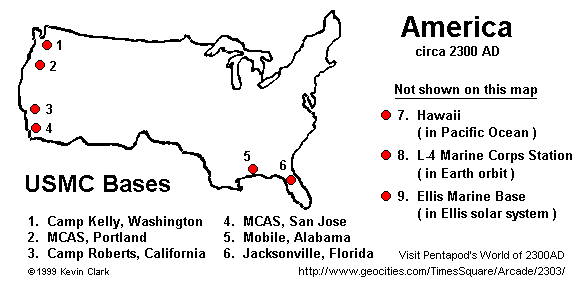
- Camp Kelly, Washington
- 1st Marine Division
- 4th Marine Division ( Reserve )
- 1st Armor Battalion
- 33rd Artillery Battalion
- 25th Air Defense Battalion
- 24th Engineer Battalion
- MCAS ( Marine Corps Air Station), Portland, Oregon
- Camp Roberts, California
- 3rd Marine Division
- 20th Armor Battalion
- 19th Artillery Battalion
- 27th Engineer Battalion
- MCAS, San Jose, California
- 10th Air Wing ( Reserve)
- 7th Air Wing
- 6th Air Defense Battalion
- 7th Air Defense Battalion
- Mobile, Alabama
- Jacksonville, Florida
- 2nd Marine Division ( less 13th Regiment)
- 9th Air Defense Battalion
- 29th Armor Battalion
- Hawaii
- 13th marine Regiment
- 30th Artillery
- L-4 Marine Corps Station
- 5th Marine Division ( less 10th Regiment and air assets)
- 8th Interface Wing
- Ellis Marine Base
- 10th Regiment ( 5th Division)
- Air assets of 5th Division
- 12th Armor Battalion
- 8th Artillery Battalion
ORGANIZATION: FORMAL
The US Marine Corps
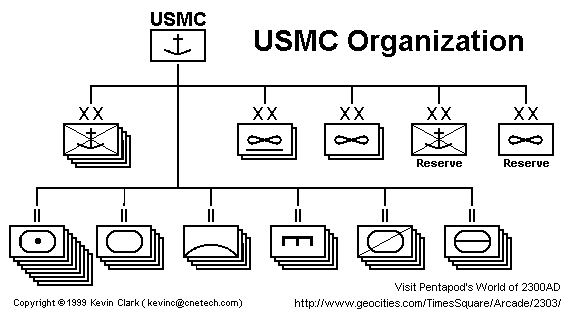
The modern marine corps is a large organization consisting of four marine
divisions, two interface wings, and two air wings. Providing support
for these units are eight artillery battalions, four armor battalions, four
air defense battalions, four engineer battalions, four recon battalions,
and four APC battalions. Additionally, one marine division and one
air wing are attached in reserve. These units possess their own assets
normally found only at the corps level. This is done so that all
reserve units are under the command of either the reserve division or air
wing.
The Marine Division
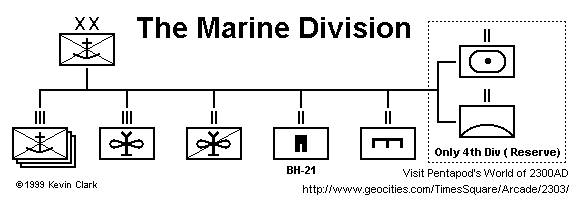
The US Marine Corps operates five divisions: four active and one reserve.
Divisions are organized identically, each with three marine regiments,
one air regiment, one air recon battalion, one combat walker battalion,
and one engineer battalion. The single exception is the 4th Reserve
Division, which has one artillery and one air defense battalion directly
attached. This was done so that these battalion-sized reserve units
are all under one reserve command instead of their usual attachment directly
to the corps.
Marine Interface Wing
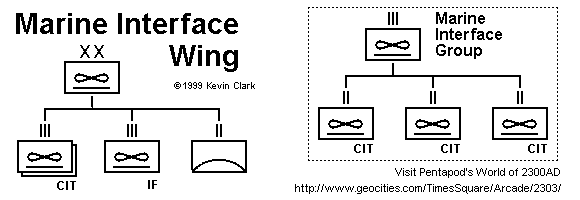
The marine interface wing and marine air wings are division-sized units
organized to provide interface and/or air support to their corresponding
marine divisions during combat. A total of two interface wings and
two air wings are in active service in the corps, with one additional air
wing operating as a reserve unit. Each interface wing is organized
into two combat interface transport groups, an interface fighter group,
and an air defense battalion.
ORGANIZATION: COMBAT GROUPS
While the marine corps is formally organized into divisions, in most
modern actions, a special combat group is formed. There are three
types of groups used in off-world operations. These are the marine
interface unit ( MIU), the marine interface brigade ( MIB), and the marine
interface force ( MIF).
Marine Interface Unit
The smallest of these groups is the MIU, which is formed around a single
marine battalion and generally supported by divisional air assets and armor.
The MIU is a strong, flexible, battalion-strength force, possessing a high
degree of mobility. With a low total strength of troops, the MIU
is easily transported by a single interface operations support vessel.
The biggest drawback of the MIU is that it is too small to be useful for
most operations. However, during the present Kafer conflict, one
unit, the 6th Marine Interface Unit, is maintained on standby in the Ellis
system. The troops are taken from the 2nd Marine Division and are
rotated on a regular basis.
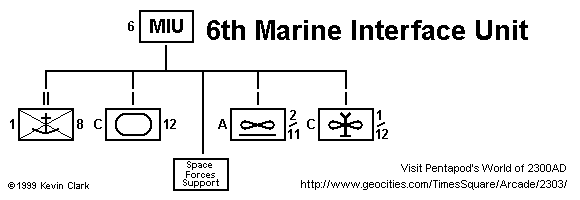
The 6th MIU is a practical example of MIU organization. The 6th
MIU is the only organized MIU and is formed with the 1st Battalion, 8th
Marine regiment at its core. In addition to the battalion, the 6th
MIU consists of C Company/12th Armor Battalion, A Company/2nd Battalion/11th
Interface Group, C Company/1st Battalion/12th Marine Aviation Regiment.
Providing direct support in the form of orbital bombardment, interface
assault support, logistics, and transportation are vessels of the American
Space Force.
Marine Interface Brigade
The larger MIB is the mainstay of present marine military operations.
The MIB is a collection of combat units, larger that a regiment and more
combined-arms oriented. One common organization of the unit is one
marine regiment, a combat interface transport group, an armor battalion,
a combat walker battalion, and an air defense battalion. At the outbreak
of the Kafer War, the US Marine Corps organized the 7th Marine Interface
Brigade and maintains the unit in full readiness at the American L-4 colony.
Recently, this unit has been reinforced with fresh troops and updated equipment.
The Pentagon claims that this is part of a general combat readiness program.
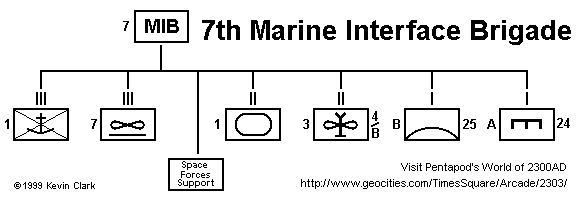
The larger, more powerful MIB is organized to make major interface assault
landings. All marine units are organized into brigades, but only
two interface brigades are active. The 7th MIB is composed of units
of the 1st Marine Division. At the heart of the brigade is the 1st
Marine Regiment. Supporting this unit in combat and providing transportation
during the initial interface assault is the 7th Interface Group.
Also attached is the 1st Armor Battalion, 3rd Battalion/4th Aviation Group
B, B Company/25th Air Defense Battalion, and A Company/24th Engineer Battalion.
The brigade also has a large contingent attached from the American Space
Force which, as for the 6th MIU, provides orbital bombardment, interface
assault support, logistical support, and transportation for the entire
brigade.
At the time of this writing, the 7th Marine Interface Brigade was being
reinforced by B Company/Artillery Battalion, as well as the remainder of
the 24th Engineer Battalion. The entire unit is scheduled to be moved
from its current location at L-4, but there is no indication as to exactly
where it will go.
Marine Interface Force
The largest marine combat group is the marine interface force. This
unit is essentially a complete marine division organized and equipped to
be fully mobilized as a single group. Because of the sheer size of
such an organization, the expenses incurred in maintaining and fielding
it, and the naval resources required to support it, these units are seldom
organized except during major wartime efforts.
At present, there are no MIFs organized. However, should there
be a need for one, the Pentagon has the plans ready to implement one.
Weapons
For many American marine units, duty is served aboard foreign vessels.
These ships are seldom equipped with American weapons or, more importantly,
compatible ammunition. For this reason, American troops aboard these
ships are generally equipped with foreign weapons. Aboard French
vessels, FAM-90s are most commonly used; aboard German vessels, SK-19s
are common, and so on.
However, most marines do not serve on foreign vessels. Instead,
they are based in America or on American colonies and ships. Standard
weapons for these personnel are American-issue equipment. Most are
of American design and manufacture, some are based on foreign designs,
and others are actually foreign-made weapons purchased by the American
government for issue to its troops. An example of this is the French
designed and manufactured FTE-10 gauss rifle which is used by American
forces under the designation M-10. The following is a list of standard
issue weapons for American marines.
M4-A1
The M-4 is an American-designed gauss rifle which, along with the M-5,
replaced the M-2 as the standard infantry weapon of the American army and
later the marines. The M-4 uses the same ammunition and clips as
the French FAM-90. However, the M-4 has a replaceable energy cell
located in the stock of the weapon which serves to supplement the ammo
clip energy cell. This was done because many ammo clips were found
to have defective energy cells, were losing their charge, or were accidentally
shorting out too often. The stock-mounted battery has enough charge
to fire one "dead" clip of 60 rounds. Power is routed automatically
as needed. The M-4 ammo clip failure rate has dropped to tolerable
levels, but the auxiliary battery unit is still kept fresh, just in case.
Additionally, a small switch will set the rifle to boost the muzzle
velocity to 1600 mps. A fresh energy cell in the rifle will boost
up to two fully charged clips.
Type: 4.5mm gauss rifle with integral 30mm grenade launcher;
Country: USA; Mass ( Empty): 4 kg; Length: 73cm (
Bulk=2); Action: Single shot or bursts; Ammunition: 4.3 x
20mm flechette; Muzzle Velocity: 1300 mps ( 1600 mps boosted); Magazine:
60-round box magazine with integral power cell; Magazine mass: 0.3
kg; ROF: 3; Aimed Fire Range: 750 m ( 850 m boosted); Area
Fire Burst: 10 ( AFV=1); Area Fire Range: 450 m ( 500 m boosted);
DP Value: 0.5 ( 0.6 boosted); Price: Lv380 ( Lv2 for 60-round
disposable magazine, Lv1 for stock power cell).
M-57
The M-57 is the military version of the Traylor Model 57 pistol.
The military version is slightly heavier and more rugged than the civilian
model. The M-57 is standard issue to field grade officers, medics,
and vehicle crews. Also, although not standard issue for combat troops,
many carry them as a backup weapon in case of emergency. The statistics
for this weapon are the same as those for the civilian version listed in
the 2300 AD rules. The one exception is that the mass of the
military model is 0.7 kilograms.
M-103
The M-103 is a team-support weapon designed for a high rate of fire and
high stopping power. The weapon can be fired in a number of configurations.
The simplest is the standard bipod mount. A high-mobility mount is
also available and issued to all marine teams. The high-mobility
mount has a recoil- and vibration-absorbing harness which the gunner wears
around his torso. The harness has a flexible mounting arm which helps
the wearer carry and wield the weapon. The third mount is a standard
tripod which stabilizes the weapon, giving it a greater effective range
( although this reduces its portability). Finally, the weapon can
be vehicle mounted, giving it the same accuracy as the tripod mount, but
providing higher mobility.
Type: Conventional machinegun; Country: USA; Mass ( Empty):
5 kg; Length: 109cm ( Bulk = 3); Action: Single shot or bursts;
Ammunition: 5.5 x 35mm fixed cartridge ball; Muzzle Velocity:
1100 mps; Magazine: 100-round cassette or 50-round drum; Magazine
mass: 0.5kg ( drum), 0.7 kg ( cassette); ROF: 3; Aimed Fire
Range: 700 m; Area Fire Burst: 20 ( AFV = 2); Area Fire Range:
480 m; DP Value: 0.6; Price: Lv920 ( Lv2 for box of 100 rounds,
Lv5 for empty drum or cassette).
M-10
The M-10 is a sniper rifle of French design, the original designation being
FTE-13. The characteristically long gauss rifle is used by two-man
marine sniper teams. The weapon is as described in the 2300 AD
rules book with no modifications made.
M-41
The M-41 is a special, silenced version of the M-4 rifle. The weapon
is slightly heavier than a standard M-4 and is incapable of fully automatic
or burst fire, The M-41 does possess the underslung 30mm grenade launcher,
but that unit is not silenced.
Type: 4.5mm gauss rifle with integral 30mm grenade launcher;
Country: USA; Mass ( Empty): 4.5 kg; Length: 76 cm
( Bulk = 2); Action: Single-shot; Ammunition: 4.5 x 20mm
flechette; Muzzle Velocity: 1500 mps; Magazine: 60-round
box magazine with integral power cell; Magazine Mass: 0.3 kg; ROF:
3; Aimed Fire Range: 750 m; Area Fire Burst: 3 ( AFV = 0.25);
Area Fire Range: 420 m; DP Value: 0.4; Price: Lv400
( Lv2 for 60-round disposable magazine, Lv1 for stock power cell).
M-2290 A2
This heavy, man-portable plasma gun is a key weapon which is issued, as
necessary, by the marine platoon leader. In most cases, these are
supplied one per squad. In some situations, the weapon is mounted
on an APC, often in direct support of the marine squad. The weapon
is as described in the 2300 AD rules. When it is vehicle mounted,
the weapon can be fitted with a special ammo-loading mechanism which will
continually feed the weapon from a 100-round box magazine.
M-384 Al "Javelin"
The Javelin is a squad-level antiarmor missile. The shoulder-fired
missile is based on the French Blindicide-3. Although the French
weapon is now considered obsolete, the improvements in the Javelin and
its relatively low cost make it an affordable, light antivehicle weapon.
Type: Hand-carried light antivehicle; Country: USA; Launcher
Mass: 14 kg; Missile Mass: 3 kg; Range: 1100 m; Guidance:
Automatic following gunner lock-on; Homing Value: 13; Attack
Angle: Overhead; DPV: As tamped explosion ( EP = 25); Launcher
Price: Lvl500; Missile Price: Lv1300.
M-722 Stiletto
The Stiletto is a shoulder-fired light air defense missile. The weapon
is deployed at the battalion level with two Stiletto sections per marine
weapons company. The weapon is showing signs of its age and is quickly
becoming obsolete. The marine corps is now looking for a good replacement
for the Stiletto, and is considering the French Guiscard Martel.
However, initial procurement is a minimum of four years away, so the Stiletto
will still be in use for a while yet.
Type: Shoulder-fired light air defense missile; Country:
USA; Launcher Mass: 8 kg; Missile Mass: 2 kg; Range:
5000 m; Guidance: Automatic following gunner lock-on; Homing
Value: 20; Attack Angle: Direct; DPV: As tamped explosion
( EP=3); Launcher Price: Lv15,000; Missile Price: Lv6000.
-Clare W. Hess
Back to Pentapod's World: 2300AD magazine articles menu
Last Update: 1999 Apr 28
First Online: 1999 Apr 28
Pentapod's World of 2300AD - http://www.geocities.com/pentapod2300/
Website maintained by: Kevin Clark ( kevinc AT cnetech DOT com )
 This article is an overview of the bases, organization, and weapons of the USMC in
the year 2300 AD. I have found it very useful for my military campaigns. My thanks
to Clare for granting permission for me to host it on my web site.
- Kevin Clark - Apr. 28th, 1999.
This article is an overview of the bases, organization, and weapons of the USMC in
the year 2300 AD. I have found it very useful for my military campaigns. My thanks
to Clare for granting permission for me to host it on my web site.
- Kevin Clark - Apr. 28th, 1999.





